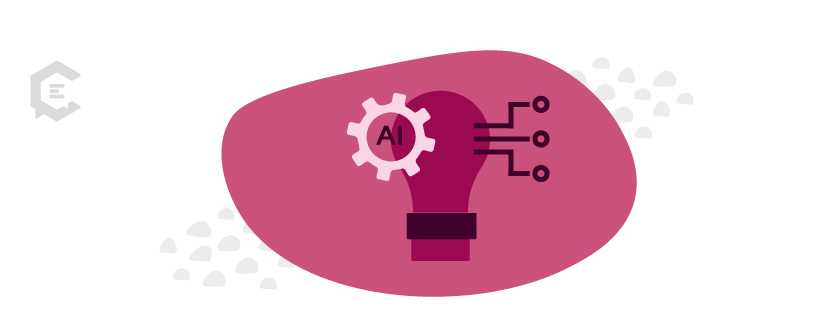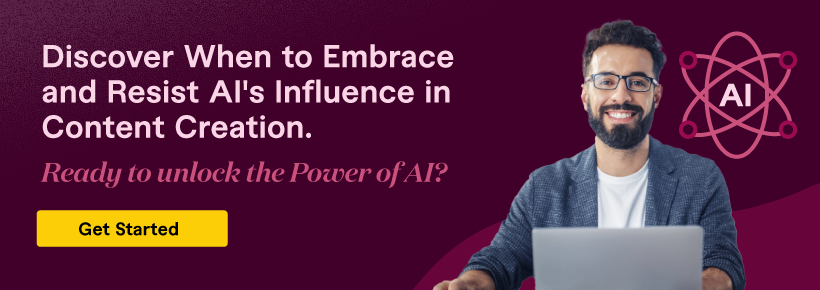Artificial intelligence and machine learning are emerging technologies disrupting industries. These advancements may impact society in ways we can’t imagine.
This has certainly been the case in the content world.
Generative AI, or AI that produces content, is making headlines throughout the world of content creation. In a recent study, 65.8% of people believe AI content is equal to or better than human-written content!
On one side, AI creates tons of readable and visual content in seconds. On the other side, content creators fear their livelihoods going up in smoke.
The truth is somewhere in the middle. Generative AI is useful for helping the content creation process, but AI requires the human element. This ensures quality control and helps content resonate with its target audience.
Understanding AI content marketing
Artificial intelligence simulates human intelligence processes. AI systems examine large amounts of data for patterns or correlations. Then these systems make tasks based on those analytics.
AIs like ChaptGPT and Google’s Bard access a universe of information from the internet. This information allows the AI to generate content, like articles or images using user-generated prompts. The results are almost instant. AI spits out thousands of words in seconds—running laps around their best human counterparts.
AI-generated content: Its limitations
Generative AI requires prompts like tone, length, language, and other factors to create content. And yes, with this information (and internet research), the system can create a helpful and informative blog post.
Your AI prompts might include:
- Keyword lists related to a specific topic: If your content is about widgets, potential keyword prompts might include “a widget,” “app widget,” or “at a glance widget.”
- Potential user questions about the topic: Users’ questions might include “what are the best widgets to use?” or “how to use widgets.”
- The keywords’ search intent: You can do this by typing the keyword (“widgets”) into a search engine bar, and examining the results. Those results are the “prompt” you’d give to the AI.
Expressing your brand voice
AI is fast. But it lacks the creativity, experience, and wisdom that professional writers or designers have. One goal of content is to nurture customers along the marketing funnel. Great content moves those customers from brand awareness to action. AI doesn’t understand your audience’s pain points. It doesn’t know what might shift your customers from impartial observers to active buyers.
Plagiarism
Another problem with using AI for all content creation is plagiarism. AI pulls from existing verbiage and visuals from various parts of the internet. It examines this information for patterns and what makes sense and reassembles them to new text or visuals.
But those words and images might be under copyright protection. This could be problematic for the brochure your AI system created. Unless you ran that piece through a plagiarism detector, you could receive a “cease-and-desist” letter or a penalty from Google.
Impact on SEO
One of the main reasons to create content is to land on the first page. So, how do search engines regard AI-generated content? Does Google penalize AI content?
The answer is yes. Google says AI-generated content violates Google guidelines. If Google catches your AI-generated content, they’ll penalize your content, which lowers your SERP rankings.
Can Google detect AI content?
The answer is no.
Google systems don’t automatically detect AI-generated content, at least without human reviewers. But this ignores what Google likes. Specifically, Google rewards content that is authoritative and relevant to users. Whether AI or a human being creates content, it won’t rank without that authority or relevance. And Google always acts against spammy content, no matter who – or what – writes or designs it.
How NOT to Use AI for Content Creation
Even with the above caveats, you might be tempted to incorporate something like a ChatGPT into your content creation efforts. But that generative AI shouldn’t be the sole source of your content.
What to avoid with generative AI
Avoid using generative AI for:
Blog-post creation and publishing: Generative AI is only as effective as the information it finds on the internet. Relying on AI for all of your blog creation opens the door to mistakes and inaccuracies. It also puts you in the crosshairs for copyright violations.
Image and art development: Your ChatGPT or WriteSonic scours the internet for artwork and images. The problem is that the AI doesn’t give credit to the original artists. This means you (via AI) are stealing art from actual artists. You don’t want to be known for copyright violations.
Subject-matter expertise: While AI simulates human intelligence, it isn’t human intelligence. Google Bard isn’t an expert in your industry or field. It doesn’t have the vast background or knowledge you do. AI pulls information from other sources. Those sources could be your competition. If you rely on AI alone, you could be publishing your competitors’ insights, instead of your own.
The Right Way to Use AI for Content Creation
AI could be a helpful tool for your content strategy. When used correctly, generative AI can help in the following ways:
1. Developing content briefs
Content briefs are an important part of your content strategy. They can also be the bane of a strategist’s existence. Briefs merge information from multiple stakeholders into one document. An AI system can bring it all together and create a useful outline that a writer can flesh out.
2. Improving social media
AI boosts social media engagement very well. Let’s say you want to generate widget content for Facebook or Twitter. An AI tool scours the internet, seeking massive amounts of information about widgets. That technology also pinpoints the most audience-appealing stuff about widgets. After generating the info, your AI can create a highly engaging post, complete with a catchy, hard-to-resist headline. Some AI tools also create hashtags, adding to the post’s engagement.
3. Brainstorming
Even the most talented writer or designer gets stuck. An AI generator can answer questions you may have about a topic and deliver surprising results. Your human team then takes care of polishing that content and making it sound (or look) great.
4. Rewriting existing content
Ask a generative AI to rewrite your case study into a 500-word blog post and be amazed by the results. But be sure to check for mistakes and inaccuracies before publishing that piece.
5. Creating meta descriptions, headlines, and titles
This written content is important to an SEO strategy. But many writers struggle with these aspects of content. Involving an AI system in this process provides many options and useable summaries.
6. Developing original images
As we explained above, using your AI to generate images from the internet is a strict no-no. However, the technology can be useful to help spur ideas for your own original artwork or graphic designs. You can also use tools like DALL-E 2 to generate original images with just a text prompt. When using AI for anything visual, be sure you aren’t stealing work from other artists or designers.
Should you replace human writers with AI?
Short answer: No.
While freelancers are not your direct employees, your guidance and feedback considerably impact their performance. And if we’ve learned anything from above, it’s that AI is useful, but we still need humans. And what better than industry-expert, vetted freelance writers and editors?!
Your impact, along with a positive working relationship, benefits their long-term reliability and productivity. Some ways to ensure a good working relationship with freelancers are:
- Be clear and concise in your expectations and feedback
- Respect their time by being prompt with payments and feedback
- Give honest feedback and allow them to correct anything that may not be going well
- Offer regular work to keep them engaged
- Give them a heads-up if you need to decrease or increase their workload
- Give praise when they do a good job
The future of AI and content marketing
When cutting through the AI generation hype remember this: the technology is great at assisting, but it shouldn’t be the sole generator of content.
New technology always disrupts the established order. People went from writing articles and books by hand to the printing press. Then came the typewriter. After that, the computer arrived.
None of these advances removed the need for human creativity from content creation. In fact, quite the opposite. It enhanced the capabilities of individual contributors, stimulated creativity, and enabled higher-quality content. This is true when discussing generative AI. AI will be another advancement in the content generation process.
Looking for human creators to assist with your content creation and strategies? Connect with us to learn more about outsourcing your content production.







